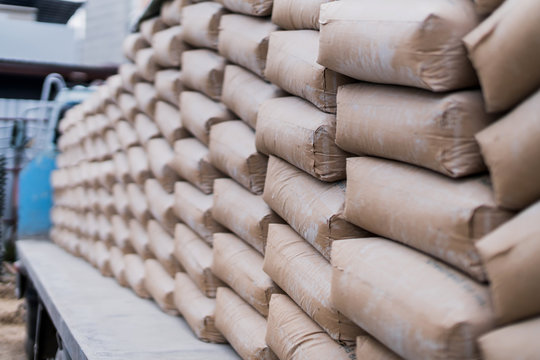•Seek cheaper alternatives
By Maduka Nweke
Cement, the backbone of modern construction, has morphed into a scarce and costly commodity in Nigeria.
Prices have climbed to unprecedented levels due to a cocktail of factors, from inflationary pressures and forex volatility to supply chain disruptions and rising energy costs. For many Nigerians, this has not only priced them out of building their own homes but has also opened the floodgates to a wave of substandard construction and property abandonment.
Fears are rife that major gigantic edifices currently being built for residential purposes may just veiled sand castles as unscrupulous builders are compromising on cement quality and quantity. This also explains why building collapses are on the rise.
So, expensive cement and fragile buildings is the double whammy Nigerians are currently grappling with.
Faced with these twin burdens, builders and homeowners across the country are being forced to rethink how they construct homes, often with troubling consequences for structural integrity and public safety.
“When the price of cement goes up, everything else in construction follows,” said Uche Chukwu, a developer in Abuja.
He continued: “You can’t plan your project properly because what you budgeted today is irrelevant tomorrow.”
As construction costs soar, the country is witnessing a rise in half-completed or abandoned buildings, a stark indicator of an industry under immense pressure.
Developers must now choose between absorbing ballooning expenses or passing them onto already overstretched buyers through increased property prices. For many, neither option is sustainable.
Worryingly, the Department of Price Control, a body that might have helped regulate the market, has become largely ineffective, much like how history studies have faded from Nigerian classrooms. The absence of active oversight has allowed cement manufacturers to hike prices with little restraint, further fuelling housing insecurity.
“Cement is no longer accessible to the average builder. And when people can’t afford it, they begin to seek alternatives, most of which compromise the integrity of structures.
“The result? A growing catalogue of weak buildings and an uptick in tragic collapses, often linked to shortcuts in materials and workmanship.
“With the rise in the price of cement, many site managers are now mixing more sand and less cement to meet targets,” said John James, an Enugu-based developer.
The Nigerian Building and Road Research Institute (NIBRRI), which was established to explore viable alternatives to conventional building materials, is quietly advancing research into local soil textures and techniques that could reduce the country’s overdependence on cement.
Mr. Rasaq Lawal, an engineer and former director at NIBRRI, explained the institute’s evolving mandate:
“NBRRI was established to conduct integrated applied research and development into various aspects of the building and construction sectors. In 1993, its mandate was expanded to include R&D into all aspects of engineering materials related to the construction industry.”
According to Lawal, the institute was tasked with developing cost-effective building systems suited to Nigeria’s unique climate and terrain, including architectural designs, plumbing, ventilation and the use of locally sourced materials.
“The department headed by the Director-General/Chief Executive Officer is also responsible for research into roads, housing, and transport,” he added. “It has standard operational labs, including a Soils Laboratory, Geotechnical Laboratory, and a GIS-based Terrain Evaluation Lab.”
To support this effort, NIBRRI established the Asphalt/Road Construction Material Testing and Research Laboratory at its Abuja headquarters. Lawal argued that similar laboratories should be replicated across Nigeria’s six geopolitical zones to scale up research and accessibility.
But the challenge, he says, is cultural.
“However, the mentality of finished products syndrome that has become part and life of the average ‘big man’ in Nigeria made the product of NIBRRI relegated to the background, with everybody chasing cement and increasing the cost per bag,” he said.
“If Nigerians were to maximize the use of soil in the building industry, like is seen in Chinese enclaves, every state and locality would be doing much with little attachment to cement except in roads and other serious constructions.”
A case in point is Anthony Onyekwe, a resourceful man from Anambra State, who recently demonstrated an innovative, low-cost method of producing bricks without cement. The video of his process—mixing sand and clay—sparked mixed reactions online. While some questioned the durability of the bricks, others praised the creativity and necessity-driven innovation.
Speaking on the trend, builder Ikenna Okonkwo noted:
“When things get tough, people devise means of survival. I am using clay to mold brick blocks, and I also found out it was the same clay that my fathers and forefathers used that gave the Oyibo people the idea of developing cement.
“Oyibo people did not start using cement until they left Africa. They were using wood, bamboo, and ropes. They learnt the molding type from Africa and maximized the use thereafter.”
Okonkwo continued:
“I made bricks using local mud, mixing sand and water, and molded the bricks without any cement. This makes the dream of lowering construction costs for prospective builders a reality. Homeownership, which has become a nightmare due to rising cement prices, would now be a possibility even for those with little income.”
Indeed, cement price hikes are rippling across the construction value chain. Prices have surged by between 30 to 50 percent in recent months. Many developers have paused projects, renegotiated contracts, or halted new site acquisitions.
Investigations reveal that members of the Cement Manufacturers Association of Nigeria (CMAN) have increased prices by over N10,200 per bag. Retail prices now range from N13,000 to N14,200 in Lagos and the Southwest, and up to N15,500 in the South East and Abuja.
Yakubu Dinbar, a cement dealer in Isolo, Lagos, described the price trajectory:
“Depending on the location, a bag of Dangote cement was selling at N11,500 in January. Earlier that month, it was N6,000. By February, it surged to between N10,000 and N15,000. By September, prices had reached N15,000 per bag.”
He added: “Unsettled by the development, the Federal Government convened a meeting with cement manufacturers and pleaded with them to bring down the prices. But Nigerians have come to understand that when the government is not involved, they will fight for the crash of prices themselves. Everyone has been asking and appealing to the government to bring down the price of petroleum products, but they refused. If the price of fuel is downwardly reviewed, prices of commodities and materials will also go down.”
Earlier this year, the Building Collapse Prevention Guild (BCPG) appealed directly to President Bola Tinubu to prevent further price hikes in cement, warning of dire consequences for national housing plans.
“Any further increase in the price of cement will be a direct threat to the ‘Renewed Hope’ Housing Programme of the Federal Government,” stated BCPG’s National President, Sulaimon Yusuf, and General Secretary, Adenike Ayanda.
“Completion of ongoing building projects might be jeopardized. Buildings abandoned during the process of construction aggravate the risk of building collapse. With dwindling purchasing power, new buildings might lack patronage and occupants due to high rental costs.”
As Nigerians grapple with economic headwinds, innovative building methods and renewed support for local research may hold the key to addressing the cement crisis. But unless these efforts receive the attention and investment they deserve, the dream of safe, affordable housing may continue to crumble—one cement bag at a time.

















Leave a comment